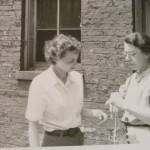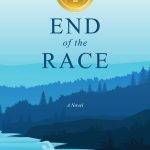I just received a review of END OF THE RACE from Diane Donovan of Midwest Reviews. Here is an excerpt:
Readers of women’s fiction who enjoy stories of challenge, transformation, and already-strong women forced to examine the foundations of their beliefs and lives will find End of the Race weaves mystery, intrigue, and self-inspection in a vivid, realistic manner.
A timely reminder to change the tune–to switch from the themes of social conflict and belonging to the true subject of the novel: challenge and transformation. These themes are as truly American as the cultural conflict we’ve been immersed in these last blogs. Let’s talk about individualism—the strength to overcome conflict and pain. To resolve. To win. A faith that somehow, in the conflicting waves of love and pain, something—or someone—better can emerge.
Finding the people that give you strength. That’s what the novel’s about:
“Set!” Joe cried. “Go!”
They flew through the air, their bodies barely skimming the surface as they hit the water, their strokes matching and matching and matching again. For a fleeting moment, he wondered if she was holding back, but flicked it off with a stroke. Annie was back. His muscles loosened. Nearing the end of the pool, they somersaulted as one person and shoved off for the second 50 meters as though wind driven, arriving together at Joe’s feet.
And the place:
Two hours later, they’d made the jaunt up the peninsula and, thankful for the thinning of summer traffic, climbed the tower to the light. Annika gazed at the land that had encompassed her life—the open arms of Traverse Bay, the vast stretch of Lake Michigan beyond, the golden ring of sand along the water’s edge. Above the shoreline, the woods were splashed here and there with the colors soon to come in full. The vastness had always overwhelmed her, calmed her churning emotions, reduced her to a mere speck, brought peace. Today it anchored her; lessened the sense of being cast adrift.
~~~~~~~~~~~~~~~~~~~~~~~~~~~~~~~~~~~~
Through much of my own life, individualism was the national focus. Neither of my parents was born into the academic world, but they found a home there. My father, a research physician, was an avid reader of history and political science. My mother, a rebel from her fundamentalist minister father, went to college and graduate school in biochemistry. A country preacher’s daughter in academia, she wasn’t always comfortable there, but it only shows up in bits of memory, such as this response to the free-write prompt (“hands”) given at writers’ meeting:
My mother hated her hands. “Too big,” she said, “and knobby.” Usually reddened and nicked. A farmer’s hands that marked her as coming from another place. All wrong for academic teas and women’s auxiliary clubs, where she’d look around at those soft white dainty hands that lay quietly in well-clad laps, tasteful rings sparkling.
It wasn’t that she had no friends. The half-dozen women who gathered monthly, her sewing circle, all loved her. Their friendship held steady as their children grew and departed. Each first-born grandchild has a quilt, blocked, embroidered, and initialed by the members. Still, I never remember a time when she didn’t look around at the delicate fingers, stitching away as they talked, and speak angrily about her own.
Mind you, she was a fine seamstress. She sewed everything we wore, from pajamas to winter coats to wedding dresses. They handled everything from canvas to silk. Dexterity was not the issue. It was place. She wasn’t one of them, and she was deaf to their admiration. Though she lived more than a half century among them, she remained a South Dakota preacher’s daughter set down among the academic elite. Her hands told the story.
I remember them beating egg whites or cake batter, helping puppies to be born. I see them scarlet as she pinned wet sheets to the backyard lines in temperatures barely above freezing. I watch them grow red and sore as she plucked pinfeathers and cleaned the insides of the Thanksgiving turkey. I still see them glow in the steam at the boiler, bleaching my father’s white shirts, wringing out dishrags and mops, scrubbing Chicago soot from walls and floors and windows. And, of course, I remember them at the sewing machine where their size did look awkward as she threaded needles or handled lace. I have no memory of them at rest.
As my sister and I grew, my mother expressed her relief that our hands were not like hers. Our hands, plus our slender ankles, marked us as relieved of a grievous burden. We belonged. That, or course, didn’t save us from scrubbing walls, or stitching hems, ironing shirts or beating eggs. Though we were occasionally taken to university events as academic offspring, the gothic enclosed quadrangles a block away were, for us, simply a place to skate or ride bikes. We had little regard (yet) for the expectations they immortalized.
The other day, a good friend pointed to my mother’s hands in a family wedding picture. They hung at her sides, fingers slightly curled, as though just finished with some task or uncomfortable with such inactivity. “You hold your hands just like that,” she remarked.
I smiled, surprised and gratified.
Clearly, this is a strong woman and a unique individual. She believed deeply in commitment to family. My husband once commented that she treated raising children as a profession—a view that conflicts with current values. Such is the hodgepodge of conflicting forces many if not most Americans live with. My characters appear and cope with them, and with each comes insight and resolution. I have faith that with each, someone better emerges.


Comments are closed.